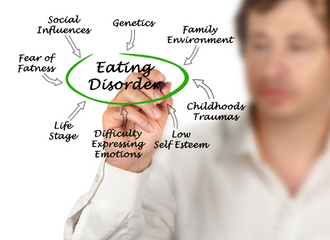Written by: Samantha DeCaro, PsyD
Director of Clinical Outreach and Education, The Renfrew Center
 Eating disorders rarely travel alone; various co-morbid diagnoses frequently exist alongside them, and the most effective treatment targets the common denominator at the root of each issue. This post examines the issues associated with the combination of anxiety and eating disorders.
Eating disorders rarely travel alone; various co-morbid diagnoses frequently exist alongside them, and the most effective treatment targets the common denominator at the root of each issue. This post examines the issues associated with the combination of anxiety and eating disorders.
Generalized anxiety disorder (GAD) often co-occurs with eating disorders, sometimes as a pre-existing condition exacerbated by malnourishment or a new diagnosis secondary to it.
Anxiety can manifest in a variety of contexts throughout the course of an eating disorder and during the recovery process as well, including intense anxiety around food, appearance, social situations, and self-efficacy.
Let’s take a closer look at each of these four areas.
#1: Anxiety and Food
Those with eating disorders often experience intense anxiety around food; however, the anxiety can surface in a variety of very specific scenarios.
Many individuals with eating disorders have a list of “safe” foods in a rotation and try to completely avoid “unsafe” foods (or only allow them during binge and/or purge episodes) to manage their anxiety. Some will rely on the use of elaborate food rituals while eating to cope with their distress or eat in secret due to intense anxiety associated with eating in front of people.
Trying new foods or recipes often evokes intense anxiety especially if the caloric content, ingredients, or cooking method remains unknown.
It is not uncommon for those with eating disorders to decline invites that involve fear foods, such as birthday parties, cook outs or other celebratory events. A simple activity like grocery shopping can often become overwhelming and time-consuming due to the fear and anxiety associated with the plethora of labels (e.g., “guilt free,” “sugar free,” “fat free,” “diet friendly,” etc.) that send contradictory and confusing messages about what is “healthy” and what is not.
In the early stages of recovery, eating new foods that seem “unsafe” can bring on intense anxiety including stomach pains, muscle tension and other physical experiences that can potentially interfere with appetite and meal completion.
While in treatment, a supportive treatment team and/or community of peers can make mealtime a much easier and more enjoyable experience. Over time, tolerance to anxiety improves, the body heals, hunger/fullness cues return, and a variety of foods become a source of nourishment and pleasure once again.
#2: Anxiety and Appearance
Anxiety about weight, size, shape, and appearance are all very common experiences for those with eating disorders. Internalized beliefs often drive this anxiety, such as the faulty idea that we should equate weight loss with wellness. Internalized fat phobia and weight stigma seem to be at the root of many of these automatic thoughts and deeply held core beliefs.
Those with eating disorders often fear that everyone around them will notice and judge them harshly, and as a result will sometimes go to dangerous lengths to change or control their bodies. These intrusive thoughts drive compulsive behaviors including wearing baggy clothing to hide their bodies, avoiding pictures, body checking, and many other maladaptive strategies.
In eating disorder treatment, the work involves repeatedly challenging the notion that worth and wellness can be measured by weight, and helping individuals identify and live a life in alignment with their authentic values, interests, and strengths outside of their appearance.
#3: Anxiety and Social Life
Eating disorders often provide a false sense of identity in a variety of ways. Those in recovery sometimes experience significant anxiety around re-entering their social circle, as their previous role as the “disciplined” or “fit” friend is no longer conducive to recovery.
There can be intense anxiety when spending time with friends after treatment, including a fear that they might face critical comments or intrusive questions about weight, what they’re eating or how much of it they’re having.
Recovery often requires experimentation with new relational responses, including setting boundaries, expressing emotions, asking for support, and communicating needs, all of which can significantly heighten anxiety.
Social media platforms also frequently fuel anxiety, especially when time online is used for comparison rather than connection. Therapy can provide an opportunity to discover or rediscover an authentic identity and teach the communication skills needed to sustain healthy, supportive relationships.
#4: Anxiety and Self-Confidence
Recovery can be a challenging process both physically and mentally, and anxiety can arise when thinking about the future. This includes navigating the various roles and responsibilities of life, work, school, and/or family without the crutch of the eating disorder.
Those in the residential level of care frequently experience anxiety about returning to their home environment without the support and accountability of a multi-disciplinary treatment team and a community of supportive peers.
Those in recovery sometimes wonder if they’ll be able to find the strength and courage to continuously sit through intense urges, ask for support when needed, admit when they’re struggling, or disclose slips to their treatment providers.
While in treatment, financial stress can also activate anxiety and increase pressure to “get the most” out of the treatment stay. In therapy, confidence and emotional self-efficacy can be built through a series of small victories and gradual exposures. By designing and executing small, achievable goals every day, emotional and physical experiences become much easier to manage, slowly strengthening the belief that sustainable change is truly possible.
Conclusion
Change is possible. With a transdiagnostic therapeutic approach, anxiety can simultaneously be treated alongside the eating disorder – resulting in improved tolerance to distress in a variety of scenarios and a renewed willingness to approach anxiety-evoking situations in the future rather than avoid them.
These exposure skills can be used indefinitely, creating endless opportunities to build emotional and physical resilience. Although anxiety can temporarily increase in the beginning stages of recovery, consistent nourishment, communication skills, an authentic identity, and self-confidence can all mitigate anxiety in the long term.


